What Is Baking Spread?
The baking spread is a substitute for butter. It is not butter, but rather, a butter-like spread made of bovine fat and other ingredients. Stork butter, on the other hand, is not butter either but is margarine that is manufactured by combining water and palm oil. People often use stork butter than butter while baking because these traditional baking ingredients typically create a better rise when used in baking cakes. Both baking spread and stork butter can be used for various pastries, from cupcakes to big cakes. If you need to create a dairy-free cake, pick stork butter over the baking spread, as the baking spread still has bovine constituents. The same applies to vegan cakes if you want to remove most traces of animal-sourced ingredients.
To clear up any confusion, butter is 80% fat and comprised of milk-derived fats. The water content of butter is less than 20%. Margarine is also 80% fat, but the fat is derived from plant oils like palm oil. Palm oil is the most common ingredient for making margarine. Margarine’s water content is also less than 20%, making margarine a good choice for baking and similar projects. And then we have the spreads. This is where the difference becomes apparent for spreads because even though these spreads are made for baking, they have less fat than margarine and butter at 60% or less. The actual fat content varies from brand to brand, but this is the average fat content. The fat source for spreads can be bovine fat or plant-based oils, or a combination of both. Spreads also have more water than the previous two, at >40%. So if you want to cook with these ingredients, pick your fat source smartly.

